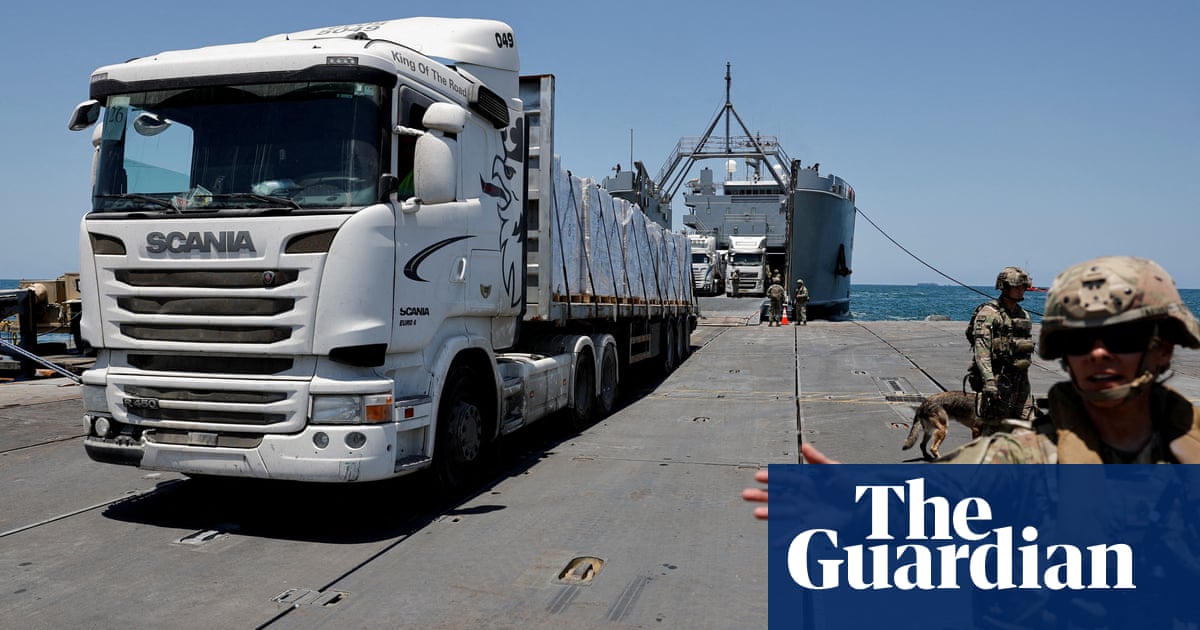World
US Gaza aid pier to be permanently dismantled after operating for just 20 days

A US military pier, built two months ago as a way to bring sea-borne humanitarian aid into Gaza, is to be permanently dismantled within a few days, US officials have told reporters.
The officials said the pier, which has had to be moved repeatedly to avoid bad weather, would be reconnected to the Gaza coastline on Wednesday but would operate for just the next few days before being disassembled by the US army and navy.
The pier would be put back in place only long enough to move humanitarian supplies which have accumulated in Cyprus and on a floating dock offshore since the pier went out of action on 28 June as a result of weather conditions, according to the Pentagon’s current plan.
The chief Pentagon spokesperson, Maj Gen Pat Ryder, said on Tuesday that the pier was currently at the Israeli port of Ashdod, the haven used during bad weather, but added: “My understanding is that CENTCOM [US Central Command] intends to tentatively re-anchor the pier this week.”
Ryder did not comment on the longer term prospects for the pier. Aid workers familiar with the project had been predicting for weeks that the pier would not survive beyond July.
The pier scheme, first unveiled by Joe Biden in his State of the Union address in March, was always intended to be a temporary measure to complement the meagre amount of aid being allowed across land crossings by Israel, but US officials told Reuters in June it would last until August or September.
The eastern Mediterranean off the Gaza coast had been choppier in the summer months than had been expected with stormy weather making it necessary to move the pier in and out of position repeatedly.
Since it was first manoeuvred into position on 17 May, the pier has been operational for fewer than 20 days, and for most of those days, aid deliveries were simply unloaded on the beach without being distributed around Gaza because of security concerns.
The World Food Programme (WFP) suspended distribution convoys on 9 June, after the Israel Defense Forces (IDF) conducted a hostage rescue operation that saved four Israeli hostages but killed 274 Palestinians. Apart from a day’s operations to clear the backlog of humanitarian assistance on the beach, the WFP has continued to suspend its convoys pending a full security review.
Over its two months in operation, about 8,800 metric tons of aid has been unloaded off the pier, about 500 truckloads, equivalent to a single day of deliveries before the war began.
Critics of the scheme warned that the spectacular $230m project would divert attention from the international effort to pressure Israel to open the land crossings into Gaza, the most efficient means of delivering assistance to the 2.3 million Palestinians trapped in Gaza, more than a quarter of whom are in imminent danger of famine.
Land deliveries have dwindled dramatically since Israel launched an offensive on the southern border city of Rafah in May. According to UN figures, the number of trucks entering Gaza through two remaining open crossings, Keren Shalom and Erez West, fell from 840 in May, to 756 in June to only 18 so far in July.
The US Agency for International Development (USAID) referred questions about the pier’s future to the defence department but a spokesperson added: “What we continue to focus on is getting urgently needed aid to people in need across Gaza through all available mechanisms.”
“Ashdod port is open for humanitarian deliveries and we expect humanitarians will increasingly use this route,” the spokesperson said.
“Erez West and Kerem Shalom are also open, though insecurity and kinetic operations are constraining onward distributions within Gaza. The United States is actively involved in discussions with Israel, the UN, and other humanitarian organizations to determine ways to overcome these constraints and allow assistance to reach people in desperate need.”









